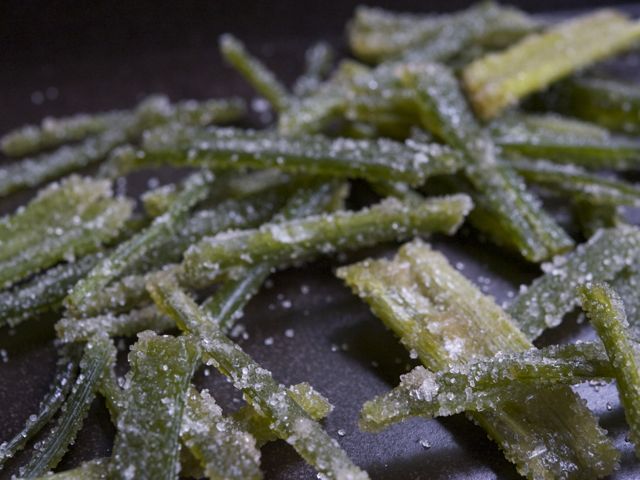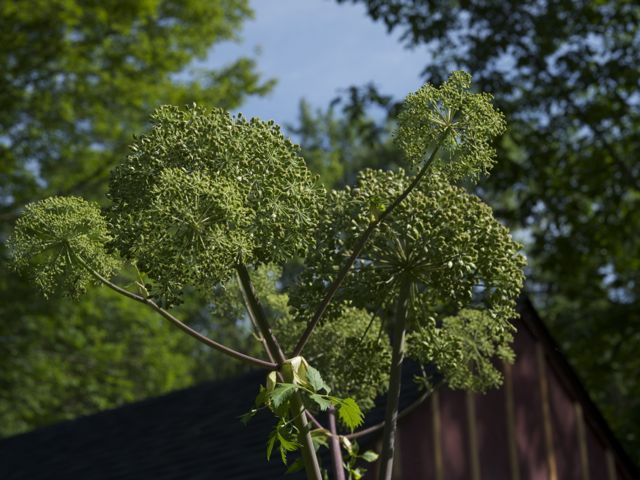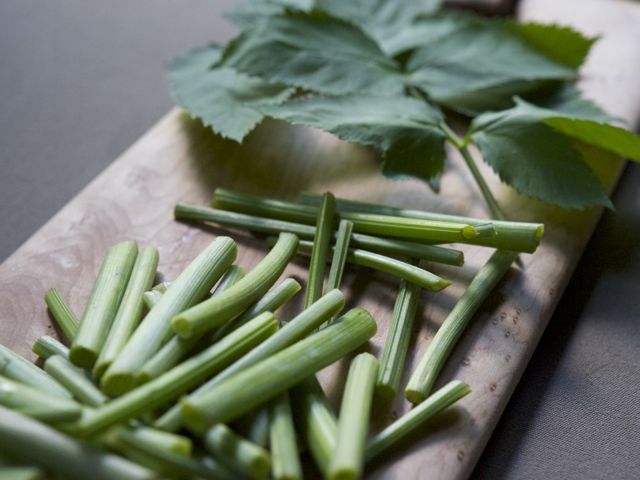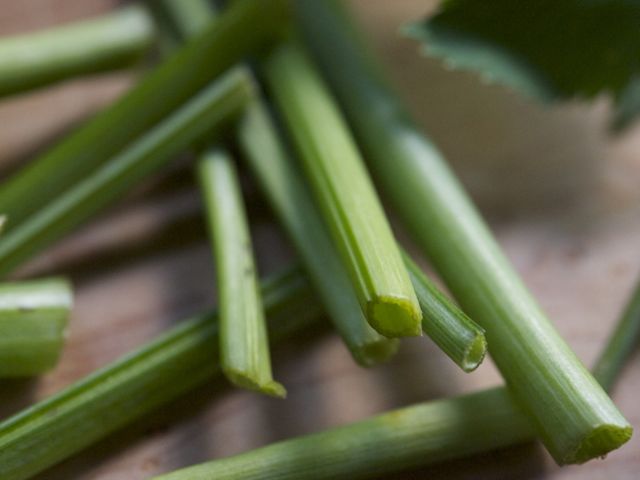2.1.12 Angel of the Garden

Angelica, known in some parts as Holy Ghost or Wild Celery, is a member of the genus Umbelliferae, which also endows the kitchen with parsley, carrot, parsnip, fennel, anise, coriander, celery, dill, cumin, lovage and caraway. Its subtly sweet flavor hints at many if not all these sister plants, with prominent notes of licorice and celery. Its botanical name, angelica archangelica, derives from the legend that it was the archangel Michael who told of its medicinal use, and every part of the plant has been prized for centuries for remedies addressing diverse complaints, especially digestive and bronchial problems. The leaves are used for tea; the roots and seeds flavor wine and spirits, including gin, Chartreuse, Bénédictine, vermouth and absinthe; the ground dried root and candied stems are added to baked goods; and the fresh leaves enliven salads, soups, stews, custards and ice cream. A flute-like instrument with a reedy sound can even be made of its hollow stem (entertaining for kids), and I’ve also seen the stems used as straws for drinks.

Angelica comes up early and faithfully every year in my garden, along with the rhubarb and the bee balm. Many old recipes specify that angelica should be cut sometime in April for candying. Early May is probably also OK; you just want to be sure that the stems are still green and not becoming horsey and purplish. Once the plant blooms, it’s probably too late to harvest them for this purpose. The way the weather has been going this winter, I wouldn't be surprised to see its green head crowning any time.One note on harvesting angelica: The plant is full of terpenes, a resin-like organic compound that is released more actively in warmer weather. Be sure to wear gloves and long pants when cutting angelica, as any "juice" that gets on you will react with sunlight and can cause a terrible burn that may scar.

In the past, I have used the leaves to make
angelica butter, but last spring I decided to candy the stems. To my shame, they've been sitting unused in a jar since then. This might be the moment to try some sort of extreme fruitcake, although it would also be good in gingerbread or biscotti, I think.

A little research turns up surprisingly consistent recipes for candying angelica stems. It's a bit of a process, as the stems can be tough and stringy, sort of like cardoons or old celery. I love this old gem, from The Accomplished Housekeeper and Universal Cook published in London in 1717:"Gather your Angelica in April, cut in lengths, and boil it in water till it becomes tender. Having put it on a sieve to drain, peel it, and dry it in a clean cloth, and to every pound of stalks take a pound of double-refined sugar finely pounded. Put your stalks into an earthen pan, and strew the sugar over them. Cover them close, and let them stand two days. Then put it into a preserving-pan, and boil it till it is clear. Then put it into a cullender to drain, strew it pretty thick over with fine powder sugar, lay it on plates, and dry it in a cool oven, or before the fire."And that's pretty much what I did. I added a touch of baking soda which helps the angelica retain its glorious green color.

Over several days, you pour hot sugar syrup over the angelica stems four times, draining them and then drying overnight each time. On the last day, you drain the syrup into a saucepan and cook it to 245º. Then you add the angelica to the pot and boil it until the stalks look translucent. For longterm storage, you can either leave the stems in the syrup (refrigerate or can), or remove the stems to a drying rack and sprinkle them with sugar to crystallize them, which is what I did.

If your curiosity is piqued, but not enough to make your own, you can buy candied angelica
here. They are out of stock now, but try checking back in the late spring.In the meantime, in case you happen to have some candied angelica hanging around—or are simply inspired to try an old school fruitcake—here's an intriguing recipe loaded with candied fruit, butter and eggs from none other than Martha Washington. I read both that she prepared it for George in celebration of their wedding anniversary, and that she baked it for her grandmother. Either way, it's an 18th-century classic, worth revisiting 300 years later. Talk about history in the making.
Martha Washington's Great Cake
-
— 2 cups golden raisins
-
— 1 1/4 cups dried currants
-
— 1 cup candied citron, chopped
-
— 1 cup candied orange peel, chopped
-
— 3/4 cup candied lemon peel
-
— 1/2 cup candied red cherries, chopped
-
— 1/2 cup candied green cherries, chopped
-
— 1/2 cup candied angelica stems, chopped
-
— 1/2 cup brandy
-
— 2 cups butter, softened
-
— 2 cups organic cane sugar
-
— 10 farm fresh eggs, separated
-
— 2 teaspoons fresh lemon juice
-
— 4 1/3 cups unbleached all-purpose flour
-
— 1 teaspoon ground mace
-
— 1/3 teaspoon ground nutmeg
-
— 1/2 cup sherry
-
— candied red cherries, optional
-
— candied angelica stems, optional
-
— confectioner's sugar, optional
Combine first 9 ingredients; stir well. Let stand overnight.
Preheat oven to 350º.
Cream butter in a large mixing bowl; gradually add sugar, beating until light and fluffy. Add egg yolks, one at a time, beating well after each addition. Stir in lemon juice.
Combine flour, mace and nutmeg; add to creamed mixture alternating with sherry, beginning and ending with flour mixture. Mix well after each addition. Stir in reserved fruit mixture.
Beat room temperature egg whites until stiff peaks form; fold into batter.
Spoon batter into well-greased and floured 10" tube pan. Place a large pan of boiling water on lower oven rack. Bake cake at 350º for 20 minutes; reduce temperature to 325º and bake an additional hour and 40 minutes or until a toothpick inserted comes out clean.
Cool cake completely in pan. Remove from pan, and sift confectioner's sugar over the top, then decorate with candied red cherries and angelica, if desired.
 Download Recipe
Download Recipe
 Download Recipe
Download Recipe












2 Comments